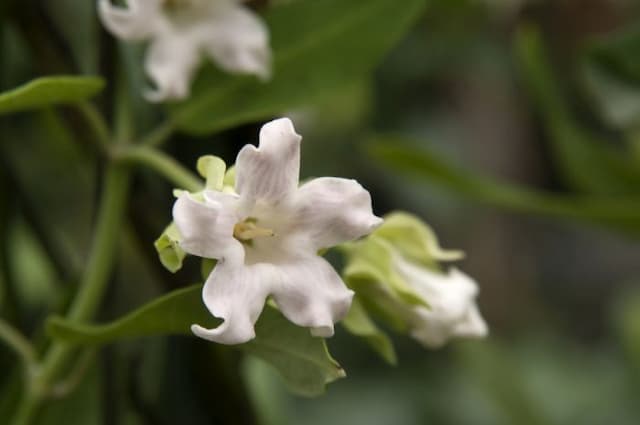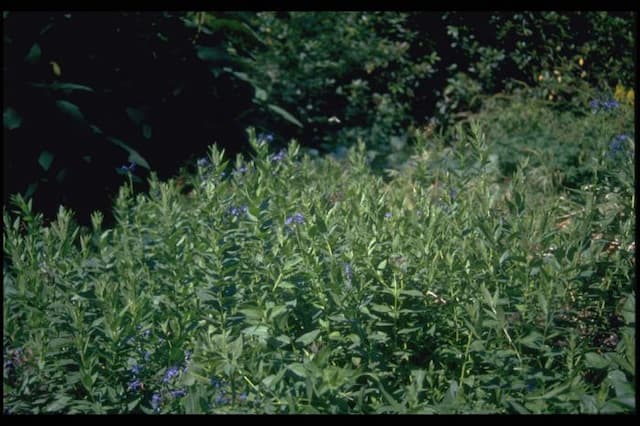Parachute Plant Ceropegia sandersonii

ABOUT
The plant commonly known as the parachute plant has a distinctive and intriguing look, primarily due to its unique flowers. The flowers have a parachute-like appearance, thanks to a fusion of several petals that create an umbrella-shaped structure. These greenish-yellow to khaki blossoms are mottled with dark maroon spots, providing a striking contrast. The parachute plant’s flowers resemble little inverted lanterns or parachutes, which is how it gets its name. The leaves of this plant are slender and tend to grow in pairs along the trailing stems, with a glossy green surface that may sometimes have a slightly bluish tint. The overall structure gives this plant a delicate and somewhat whimsical appearance, and it often captures the interest of those fascinated by unusual botanical specimens.
About this plant
 Names
NamesFamily
Apocynaceae
Synonyms
Parachute Plant, Fountain Flower, Umbrella Plant, Parachute Ceropegia
Common names
Ceropegia distincta, Ceropegia sandersonii forma distincta
 Toxicity
ToxicityTo humans
The Ceropegia sandersonii, commonly known as Parachute plant, is not widely known to be toxic to humans. There are no significant reports or evidence indicating that the Parachute plant causes poisoning when touched or ingested by humans. However, as with any plant, it is still recommended to exercise caution and avoid ingesting plant material that isn't confirmed to be edible, as individual allergic reactions or sensitivities could occur.
To pets
For pets, the Parachute plant, is also not widely recognized as toxic. There is no substantial documentation suggesting that Ceropegia sandersonii causes toxicity in household pets such as cats and dogs when they come into contact with or consume this plant. It is, however, always prudent to monitor your pets around houseplants and discourage them from chewing on any plants, as individual animals might have adverse reactions, and some plants may not have been thoroughly researched for their toxicity to pets.
 Characteristics
CharacteristicsLife cycle
Perennials
Foliage type
Evergreen
Color of leaves
Green
Flower color
Greenish-yellow
Height
1-2 feet (0.3-0.6 meters)
Spread
1-2 feet (0.3-0.6 meters)
Plant type
Climber
Hardiness zones
10
Native area
South Africa
Benefits
 General Benefits
General Benefits- Attracts Pollinators: Ceropegia sandersonii, commonly known as Parachute Plant, lures in insects like flies which assist in its pollination process.
- Unique Aesthetic: It has distinctive parachute-shaped flowers which add an exotic and unique visual interest to indoor and outdoor gardens.
- Low Maintenance: The Parachute Plant is relatively easy to care for, requiring minimal attention once established, making it a good choice for busy or novice gardeners.
- Drought-Tolerant: Being a succulent, it can endure periods of dryness, storing water in its stems and leaves, which makes it ideal for water-wise gardening.
- Adaptability: It can adapt to different growing conditions, which enables it to thrive in a variety of environments, whether indoors or in a greenhouse.
- Non-invasive: Unlike some other garden plants, Parachute Plant typically does not spread uncontrollably, so it won't overrun other plants in your garden.
 Medical Properties
Medical PropertiesThis plant is not used for medical purposes.
 Air-purifying Qualities
Air-purifying QualitiesThis plant is not specifically known for air purifying qualities.
 Other Uses
Other Uses- Ceropegia sandersonii, commonly known as Parasol Flower, can be utilized as a curiosity plant because of its unique blossom shape resembling an umbrella parachuting in the air.
- The Parasol Flower may be used as a subject in botanical studies and research due to its complex flower structure, which is designed to temporarily trap flies for pollination.
- In educational settings, the plant serves as an example of co-evolution between flowers and their specific pollinators.
- It can be used as a centerpiece or conversation starter in social gatherings because of its interesting flower shape and pollination strategy.
- Parasol Flower might be included in exotic and rare plant collections for enthusiasts and hobbyists seeking to showcase unusual species.
- The plant can be used in floral arrangements, particularly in avant-garde or conceptual art pieces that focus on the unique forms in nature.
- In photography, Ceropegia sandersonii serves as an intriguing subject for macro photography because of its detailed and intricate flowers.
- It can be used in themed garden designs, such as fantasy or fairy-tale gardens, due to its otherworldly appearance.
- Artists and illustrators may use the Parasol Flower as inspiration for patterns or designs in fashion, textiles, or graphic art.
- Ecologically, it can be nurtured to encourage the presence of certain fly species that are its natural pollinators, thereby supporting local biodiversity.
Interesting Facts
 Feng Shui
Feng ShuiThe Parachute Plant is not used in Feng Shui practice.
 Zodiac Sign Compitability
Zodiac Sign CompitabilityThe Parachute Plant is not used in astrology practice.
 Plant Symbolism
Plant Symbolism- Deception: Ceropegia sandersonii, commonly known as the 'Parachute Plant,' features unique flower shapes that resemble parachutes or umbrellas, capable of trapping flies for pollination, hence symbolizing trickery or deception in nature.
- Attraction: Its peculiar flowers and ability to attract insects as part of its pollination strategy, lend it the symbolic meaning of allure and fascination.
- Survival: As a succulent, the Parachute Plant is adapted to survive in tough environments with little water, symbolizing resilience and the ability to thrive against the odds.
- Rarity: It is not a common plant to find easily in nature or in cultivation, which symbolizes uniqueness and value in rarity.
 Water
WaterThe Parachute Plant should be watered when the top inch of soil feels dry to the touch. Ideally, watering every 1 to 2 weeks is sufficient, but this can vary based on the humidity and temperature of the environment. Use room temperature water to thoroughly soak the soil until water runs out of the drainage holes. Allow excess water to drain away, as the Parachute Plant does not like to sit in water. On average, this might equate to approximately 8 to 16 ounces of water every couple of weeks, adjusting for the plant's size and pot.
 Light
LightThe Parachute Plant thrives best in bright, indirect light. It can tolerate some direct sunlight but too much can scorch the leaves. A north or east-facing window would be an ideal spot for this plant, providing it with the gentle morning light and protection from the harsher afternoon sun. Avoid placing it in deep shade, which can stifle its growth.
 Temperature
TemperatureThe Parachute Plant prefers a temperature range between 60°F and 85°F. It should not be exposed to temperatures below 50°F, as cold can be detrimental to it. The ideal conditions would maintain a consistent temperature around the middle of this range, avoiding sudden drops or spikes in temperature which can stress the plant.
 Pruning
PruningPruning the Parachute Plant is primarily for removing dead or damaged growth to maintain its appearance and health. It can be done as needed throughout the year, but it's best to do any major pruning in the spring or early summer, which can stimulate new growth. Make sure to use clean, sharp scissors or pruning shears to make clean cuts.
 Cleaning
CleaningAs needed
 Soil
SoilThe parachute plant prefers a well-draining soil mix consisting of one part perlite, one part coarse sand, and two parts peat or a peat substitute. The ideal pH for this soil mixture should be slightly acidic to neutral, ranging from 6.0 to 7.0.
 Repotting
RepottingThe parachute plant should be repotted every two to three years to refresh the soil and prevent the roots from becoming pot-bound. It's best to repot in the spring or early summer.
 Humidity & Misting
Humidity & MistingThe parachute plant thrives in moderate to high humidity levels, ideally between 40% and 60%. It can tolerate lower humidity but would benefit from regular misting.
 Suitable locations
Suitable locationsIndoor
Place in bright, indirect light and maintain humidity.
Outdoor
Shelter it in a warm spot; protect from frost and heavy rain.
Hardiness zone
10-12 USDA
 Life cycle
Life cycleThe Ceropegia sandersonii, commonly known as the Parachute Plant or Umbrella Plant, begins its life as a seed that germinates in well-draining soil with moderate water and partial sun. Upon germination, a small rosette of leaves will form as the seedling establishes itself. As the plant matures, it develops a climbing or trailing stem with heart-shaped leaves and starts to produce its distinctive parachute-like flowers that are adapted for pollination by flies. After pollination, the flowers develop seed pods that contain the small, light seeds which are typically spread by wind. In favorable conditions, the Parachute Plant may also propagate vegetatively through cuttings or offsets that readily take root and grow into new plants. Over time, with proper care, the plant can reach upwards of several meters in length, continuing to flower and produce seeds throughout its growing season.
 Propogation
PropogationPropogation time
Spring-Summer
Parachute plant (Ceropegia sandersonii) is typically propagated using stem cuttings. The best time to take stem cuttings for propagation is during the spring or early summer when the plant is actively growing. To propagate by stem cuttings, a healthy stem should be selected and cut into sections that are about 4 to 6 inches (10 to 15 centimeters) long, ensuring each cutting has at least one node, which is the point where leaves emerge. The cut end can then be allowed to callous over for a day or two to reduce the risk of rot. After that, the cutting can be placed in a well-draining potting mix, ensuring the node is buried where roots can form. Keeping the soil lightly moist and providing warmth and indirect light will encourage rooting. Roots typically begin to form within a few weeks, after which the plant can continue to grow and eventually be treated as a mature Parachute plant.









